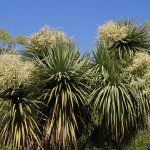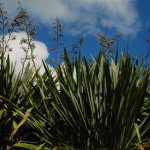Trees and Flora
The kaitiaki of the reserve have tried to plant native trees and shrubs that would have naturally occurred along the river and have named some of them with their Māori names. See if you can find 7 common trees and shrubs Tī Kōuka, Harakehe, Horoeka, Ngaio, Tōtara, Tarata, and Karamū. Click on image to enlarge.
Tī Kōuka …The tough fibres of the leaves were traditionally used for weaving baskets, making rope and string, and even making sandals. The taproot and lower stem are rich in fructose and were a valuable food source.
Harakeke… Found all along the river it was an indispensable plant for Māori. Outer leaves were used for weaving. The fibre found in the long leaves was used to make rope, fishing lines, and nets. Medicinal uses of different parts of the flax plant were many. Early European settlers found there was a market for flax because it was so strong, and it became one of Aotearoa’s first primary exports.
Horoeka… with its unique prehistorical look this tree has an interesting transformation. At about 20 years of age the long spear like leaves change to shorter more conventional leaves and form a more bush like cluster. Branches of horoeka are often straight and make good walking sticks.
Ngaio…. You can pick a Ngaio tree from its leaves. Often a light olive green in colour they have tiny spots or oil glands all over them. These contain a toxin which is a deterrent to biting insects like namu (sandflies) or waeroa (mosquitoes). A handy plant to recognise when you have forgotten your repellent!
Tōtara…One of the tall trees of Aotearoa it often symbolises strength and goodness. It was prized for building canoes, and early Europeans discovered it was a very hardy and long lasting timber even in the ground. Many Tōtara were sawn down to build the early buildings of Christchurch. You can often pick Tōtara because its short little leaves are prickly to touch and its stringy bark.
Tarata… When crushed the leaves exude a strong scent of lemon, which explains its common name as lemonwood. It has beautiful yellow flowers and if you walk by on a still warm night you will small a sweet fragrance.
Karamū… The red berries of karamū are eaten by many birds including the korimako or bellbird. They also have been a food source for Māori. You could try harvesting the little seeds to make a cup of coffee as the tree is of the same genus as coffea aribica.
So maybe that’s the note to end this little journey on. Find a local café and digest what you have learned about this rich part of our city!



